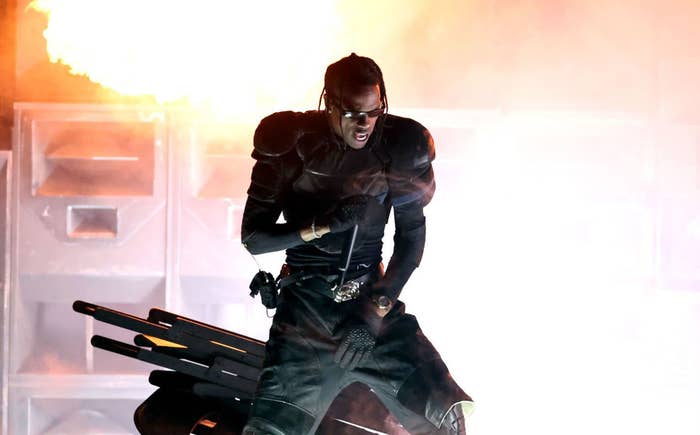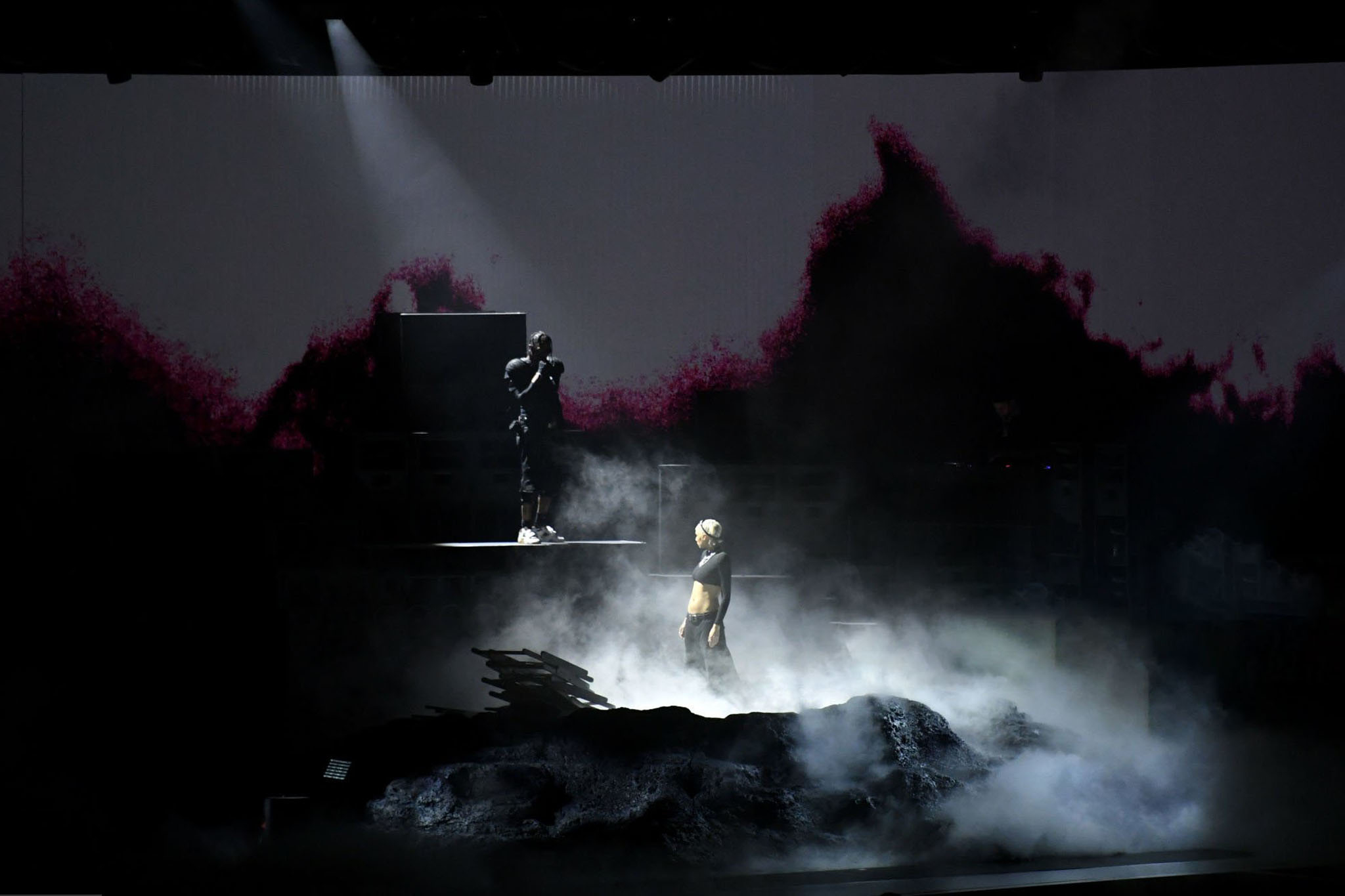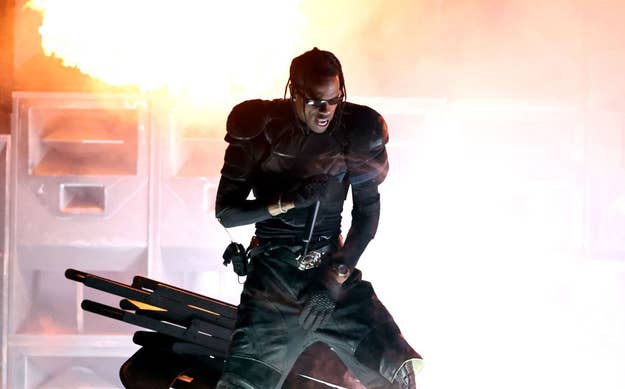
Correction [Feb. 9 at 4:50pm PT]: Schaedler's title has been updated from creative directior to scenic fabricator.
Beyond a haze of showy pyrotechnics, floating stages, and neon strobe lights is a labyrinth of logistics—what props to use and when and where to use them. A few days removed from Travis Scott’s epic 2024 Grammy Awards performance at Los Angeles’ Crypto.com Arena, his scenic fabricator Tino Schaedler gets into those before arriving at an even more basic truth about orchestrating effective stage set pieces: “In the end, it just needs to be something that looks cool.” Harnessing all the theatrics of LaFlame’s tour show dates, his Grammys showcase was a lot more than that, and Schaedler was a huge reason why.
Rocking what could be described as intergalactic shoulder pads, the Houston native brought Utopia to life with electric live renditions of “My Eyes” and the Playboi Carti-assisted “FE!N.” He started things out sitting above the speakers as shadows nearly engulfed him and fog floated throughout the stage. By the end of it all, he and Carti were bouncing around what feels like an apocalyptic hellscape, one beset by flurries of fire, chaos, and lightning. It was as relentless as it was captivating, a propulsive visual experience Schaedler worked closely with Scott to render to its fullest effect.
As a film art director with over two decades of experience, Schaedler has worked on projects like V for Vendetta and Charlie and the Chocolate Factory while also collaborating with the likes of Sault, Kendrick Lamar, The Weeknd, and more. After being approached by Scott’s team a few weeks ago, he helped make sure the Cactus Jack boss translated all the electricity of his typically immersive performances to the Grammys stage.
Speaking with Complex, Schaedler explains his role in Travis Scott’s performance, working with André 3000, and more.
Putting together a Grammys performance can be tough. What were some of the challenges that came with putting this together?
Travis was on tour, so there wasn't anything in terms of getting him much to rehearse. On Wednesday [Jan. 31], we started bringing everything over to the Grammys. On Thursday [Feb. 1], we had a pre-setup just to put everything together and it's really just about the set, almost like a tech scout you're discussing with the Grammys team, the things that need to be [there]: the fire, the pyro, where the haze and the smoke coming from, lighting. All of that is kind of like a first preliminary conversation onsite. And then on Friday [Feb. 2], we had a rehearsal with Travis. That was the first time he was basically on the set.
The first time we discussed, okay, first song, you are up here, second song, you're kind of like where his positions would be on the set. And there were a lot of things that weren't right in terms of lighting and in terms of the camera, because that's always a bit of a challenge with the Grammys, because unlike a live performance, this is a performance that's passed and seen through the camera. So we always have to put a lot of effort into making sure that the camera team from the Grammys understands the vision of the set and how we want it to be captured on camera. It’s about onboarding the Grammys' team to really understand what shots we want, what shots we don't want, and really giving them I guess the sensitivity to understand what the performance is about. Our first rehearsal wasn't great. Second rehearsal was kind of maybe 70% and then more notes and they got it. So that was really kind of why I'm happy about the final performance because it all came together super perfectly.
It felt like there were big apocalyptic vibes with this performance. Can you explain Travis’ concept for this?
He's been on tour with Utopia and they had the tour design already created — that kind of Earth fault-line aesthetic. And I think we were taking that and really pushing it and adapting it to the Grammys stage, which is a completely different space and a completely different setup. Conceptually, the way that Travis talks about Utopia in general is his version of what “utopia” is. So there's always the status quo of what we all find ourselves in. Then there’s the search for utopia and then there's the utopia for each of us is completely subjective and unique if you look at it kind of like, “What is my perfect scenario of how I would love my life to be?” And I think the earth, the fault line and everything comes from more, less from a destructive point of view, but more kind of, he did that film for the album with Harmony Karine, and they shot parts of it in Iceland. And in the end, destruction is also kind of new becoming at the same time. The fault line, there’s lava coming out and it’s destroying things, but at the same time, it’s the process of moving toward utopia.
Something that struck me was Travis’ positioning onstage. Was there any significance to him standing above the speakers for “My Eyes”?
It’s relatively straightforward and really the way that Travis thought about the drama of the three acts of performance. “My Eyes” is a really slow song and very intimate. So we wanted to give him that intimacy that was kind of like the light shaft on him and at the same time make it dramatic. I think putting him up there onto the speakers was just the perfect place. And then for him to come down, he wanted to be in three different places. He wanted space to move around on, because as you know, he's a very dynamic performer. So coming down is just the movement that makes most sense instead of going up. And it's also the way that the performance was structured from slow, intimate, to really high energy. So the place where he performed at the end for “FE!N” just gave him the most moving space. So we start there, we end there, and in between we created that landing on its way down. And that juxtaposition with the girl was the right way of staging it; that he was up there, she was down there. So it was pure show staging that gave the performance a bit of the three stages, the three acts, and changed it throughout the three minutes.
"there’s lava coming out and it’s destroying things, but at the same time, it’s the process of moving toward utopia."
Another moment that stuck out to me was when Travis started banging the chairs onstage. Whose idea was that? I have a pretty good idea [laughs].
That was Travis' idea. And it was last minute, to be honest. It was kind of like Carti was coming in and was singing at the end of “FE!N,” and Travis can't just disappear. He's not singing at that moment anymore. And I think he just wanted something that really supported that kind of vibe of being aggressive and doing something destructive on scene to really push that dynamic and feeling of intensity. I think it really added a lot. I think everyone wants to do something at the Grammys that, in one or another way, provokes a little bit. And I think that's what he achieved with the chairs.

It was kind of interesting because we had to build balsa wood breakaway chairs. So from the second to the fourth, we built all these chairs and then half of the chairs Travis already destroyed at the dress rehearsal. And then he wanted more, which we couldn't really create in a few hours. So we got in the metal chairs and we were backstage during the performance and it was so crazy loud how he was hammering those onto the steel deck.
So you’ve also worked with people like Katy Perry, Kendrick Lamar, and many more. What was it like working with Travis versus working with other artists?
It’s always a completely different thing to work with these artists. And that's also the aspect that I really love. You really get to sit down with them and hear what the music means to them, what the music for them is about. Maybe there's backstories, how the music came about, and what it's originating from. And with Travis, there was a lot kind of, because there was already a lot to get us started with the Utopia Tour, and they definitely wanted to lean into that. It was basically, “Okay, take everything and create the essence and make it kind of iconic for the Grammys.”
Having worked with all these artists, what is your favorite stage set design you’ve ever done?
My favorite set design that I put together, I would have to probably say, I can tell you what were career-changing moments in terms of projects that I've done. And the latest one would definitely be the Sault performance in London that I did in December. The reason was that it was super ambitious and it was a crazy shift from what a traditional concert can be. My interest at the moment is really into pushing music experiences into more of an immersive experience, really to enhance and create an amplified full-body experience, if you will, for people to really make it amp up the palate of how we perceive and take in these music experiences. I'm working on several projects for that, but the Sault project in London was a first step to that.
"My interest at the moment is really into pushing music experiences into more of an immersive experience, really to enhance and create an amplified full-body experience."
This sort of self-challenge seems like it keeps things fresh. Feels like that would be harder to do as you go on in your career.
We all have to learn to purify ourselves and our process. Some people have it from the get-go. I'm working with Steve Lacy. He's never done anything else than music. There's a purity about him because he always, I guess, knew what he was meant to do and he always had the confidence to, and maybe also the success. For me, it took 20 years of pushing toward what I wanted and along the way doing a lot of things that I actually really loved. I mean, don't get me wrong, I loved working on films, but I think what I'm doing right now is really what I really love doing at the moment. I don't want to say that this is what I'm always going to do, but right now this is the right place and I'm really, really loving it.
You’re working on André 3000’s new tour. What were some steps you had to take to make everything work?
We're similar in age and we met for the first time. It was like when you meet someone and you feel like, oh, you've known each other for a long time. From the get-go, there's a connection. And with him, it was very seamless. He had a sketchbook. I had a sketchbook. We started sketching into each other's sketchbooks. We got really excited about it. We were riffing off each other's words and by the end of it, we were just smiling at each other and we're like, wow, I think we got something really interesting. And that's kind of how it was. And to be honest, those conversations are really these days, why I do this. I really love doing this because there's not the slightest thing inside of me that makes me feel like, “Oh, this is work and I'm getting paid for it.”

